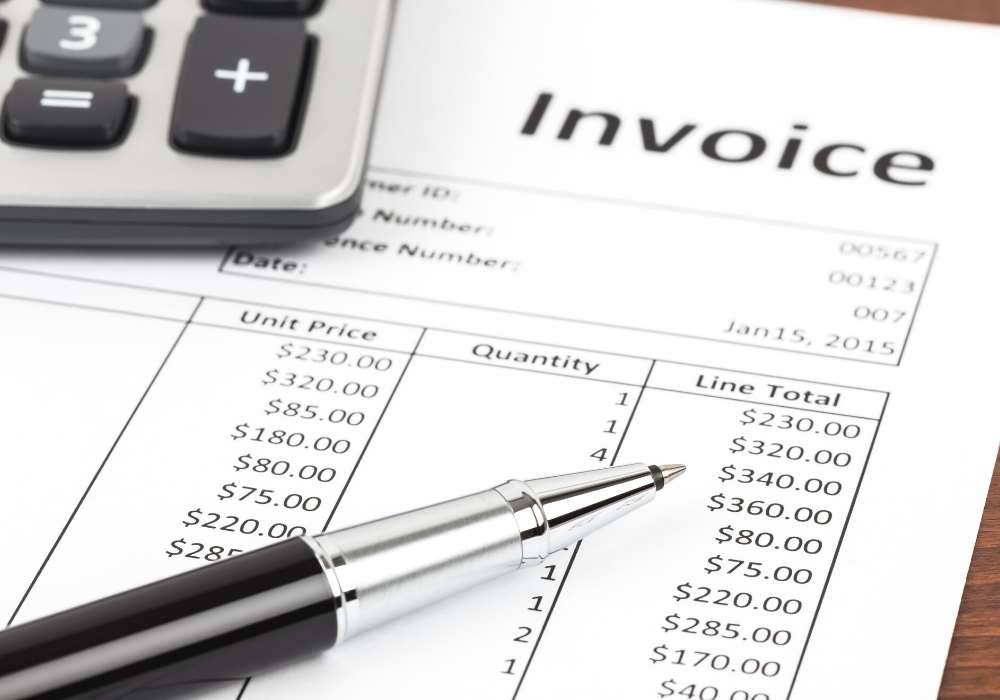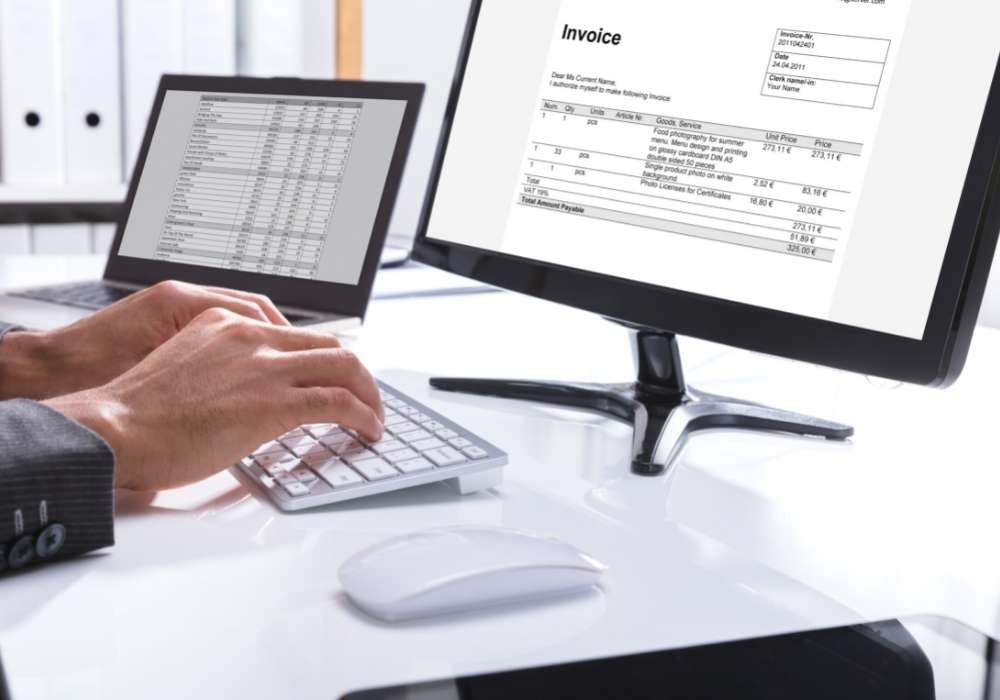As a freelancer, you aren’t going to get paid for your hard work and services if you don’t create an invoice of some sort to send to your clients. However, if you’re new to the freelancing world, it can be difficult to figure out how to write an invoice for freelance work.
I’ve been freelancing for about two years now, but only started full-time freelancing last summer after graduating with my B.A. in Graphic Design and Media Arts from university.
Over the years, I’ve tried sending invoices in many different ways; through payment processors, CRM systems, and even designing and creating them myself in InDesign.
I’ve come a long way considering I didn’t know how to send an invoice when I first started.
If you’re wondering how to invoice for freelance work, whether you’re new to this career or you’ve been in this world for a while, you’re in the right place.
Writing an invoice doesn’t have to be difficult, and the more you send them, the easier it becomes.
Here’s my guide to how to write an invoice for freelance work.
What Should An Invoice Include?
Writing an invoice and charging for your services is pertinent to keeping your business running, paying rent, and affording your other monthly expenses.
If you’re trying to figure out how to write an invoice for freelance work, start with the basics outlined below. Your invoice needs the following, but you can always add more information depending on your client’s needs.

Contact Information
First up is contact information, which includes both your contact information and your client’s.
You’ll want to make sure to include the business name, address, email, phone number, and website of both you and your client if you have it.
At the very least, make sure you include this information for your own business so your client can contact you if there’s an issue.
The contact information should be at the top of your invoice somewhere. Many invoice creator systems will do this automatically for you, so you don’t have to worry about it once you input the information.
Invoice Number
If you consistently use the same exact invoicing system, then the invoice number will automatically update for you with every invoice that you create.
If you use a few different programs, you’ll want to make sure you don’t have two of the same invoice number across platforms to go back and find invoices as needed easily.
Date of Invoice
An invoice isn’t complete without including the date that you sent it. This is just as important for your own records as it is for your client’s.
This can simply be added at the top of the invoice somewhere underneath the contact information. Make sure that the date you put is correct; don’t backdate it.
Invoice Due Date
In addition to the date you send the invoice, you should also have an invoice due date. This is the date that the payment from your client is due.
Many invoice creation tools will automatically make the due date the same as the date you send the invoice, but you can change this if needed.
If you’re wondering how to invoice for freelance work with longer contracts, you can actually set up multiple due dates with amounts due with some invoice creators, like Dubsado or Honeybook.
This allows your client to set up automatic payments and be aware of the rest of the payments coming up in the next few months.
Itemized List of Services Performed
For your client to properly know exactly what they are paying for, you need to make sure that you include an itemized list of all of the services you performed for them. Think of this as the list part of a receipt that you receive after you visit a store.
For instance, if they paid you for a social media management package, write out the package’s name, list the description of the services performed underneath, and the price it costs.
This is one of the most crucial details on an invoice.
Final Amount Due
Your client is not going to know how much is due if you don’t include a final number! Make sure this number is easy to see and is inclusive of all of the services you performed.
The best spot to put the final amount due for all services is at the bottom of the invoice in bold. This way, your client can easily spot how much they are paying before even looking over the rest of the invoice.
Bonus: Logo (a fun addition)
If you want to know how to create an invoice for freelance work in a more fun and customized way, make sure to add your logo to the top near your business information. There are quite a few different invoice creator services that will do this for you.
You can also alter the design of the invoice to make it have your brand colours and fonts. But, don’t go overboard; you can brand the invoice accordingly but still have it not be too distracting from the content of the invoice. You want this to be easy to digest for your clients.
Other Possibilities to Include
While most freelancers prefer to include payment terms within their contracts, you can also consider adding this to your invoice. This isn’t required in any way but can be helpful to remind your client if there’s a late fee of any kind.
You might also want to possibly add the available methods of payment. I personally outline this in my contracts, but some freelancers prefer to add it directly to their invoice. If you’re using an invoice creator like PayPal, then this isn’t necessary to include.
How To Write an Invoice for Freelance Work
If you’re wondering how to invoice as a freelancer, you’re probably hoping there are tools out there that will do it for you. Well, there are!
These can be extremely time-saving and can make it a lot easier to send your invoices to your clients.
Here are a few of the best tools out there to send invoices to your clients. Keep in mind that most of these do take at least a portion of your payments, unfortunately.
Dubsado
Dubsado is a go-to invoice and proposal CRM often used by freelancers offering creative services, like branding, web design, and graphic design.
This tool allows you to set up recurring invoices for your clients so that you don’t have to set up a new one to send every month if your client is on a longer contract.
One of the great aspects of Dubsado is that you can add all of your normal packages directly into it.
For example, maybe you have a website design package that you offer. Add it in as one of your packages, and when you create an invoice, you can choose the package from the dropdown menu, and it will be automatically added and calculated for you.
PayPal
While PayPal is a bit less fancy, I use it with a lot of my clients because everyone pretty much knows how to use it already.
The invoices aren’t as customizable, but they get the job done, and you can add all of the essentials that are outlined in the beginning part of this article.
HoneyBook
HoneyBook is my absolute go-to invoicing tool. All of my own social media management and graphic design clients are invoiced using this tool.
I can set up recurring invoices like Dubsado, and also add in all of my packages, which saves me so much time.
Clients can pay through bank transfer, credit, or debit card, so there are many payment options available. Your client has their pick, and can even set up their payments to be automatic so they don’t have to pay your late fee.
QuickBooks
If you’re wondering how to create an invoice for freelance work and you already use QuickBooks to stay on top of your financials, then you’re in luck. You can actually create invoices to send to your clients through it, just like with PayPal.
What’s so great about invoicing through QuickBooks is the money you make from the invoice is already in the financials software to save you some precious time.
Bonsai
Bonsai is a top-rated invoicing software among freelancers because of how easy it is to use. Like with other invoicing software on this list, you can also set up recurring invoices or one-time invoices, which can help you stay more on top of your invoicing.
In addition to invoicing, Bonsai can create and send contracts for you and track your time. It has many other features that are worth looking into if you’re trying to choose an invoice service.
Wave
Wave is similar to QuickBooks in that it sends invoices, but can also help you manage all facets of your financials. You can watch your expenses, pay subcontractors, and set up one-time and recurring invoices for your clients.
Unlike some of the other invoice software on this list, Wave also has the ability to customize your invoices for you down to the exact hex colour that you use in your branding. The customization options are endless.
Harvest
Last but not least is Harvest, which is an invoicing software that I recommend you look into if you work on hourly retainers instead of in packages.
Harvest is mainly used for time tracking and exporting timesheets, but you can send it as an invoice for your clients to pay you via the platform once you track your time.
Looking for more Freelance articles?
- 20 Best Time Management Tools For Freelancers
- How To Make Money As A Freelance Social Media Manager
- 10 Ways To Make Money As A Graphic Designer
- How To Make Money On Upwork: An Expert’s Review
- 10 High-Paying Online Jobs
- How To Create a Freelance Website (Step by Step Guide)
- 15 Best Freelance Websites for Beginners
- 25 Best Apps For Freelancers (Free and Paid)
- 15 Best Tools For Social Media Managers
- How To Start Freelancing With No Experience
- 10 Ways to Eliminate Distractions While Working at Home
How to Send an Invoice
Now that you know how to write an invoice for freelance work, it’s time to figure out how to send an invoice.
Truthfully, if you use any of the invoice software that was outlined in the prior section of this article, all you’ll have to do is send it to your client’s email address. They can then open the email and pay the invoice promptly.
If you’d rather hand-create the invoices, which I’ve done in the past, then there are a few things to keep in mind when sending an invoice to a client.
First of all, make sure that the invoice is a PDF.
Things can go wrong if you send over the live file that you created within Microsoft Word or Adobe InDesign because then the client has the chance to go in and make changes to it without you knowing. With a PDF, the client can’t change the document.
I suggest you send it as an attachment in an email and then keep a copy elsewhere so that you can easily find it if you need to refer back to it.
Sending an invoice that you created on your own via email also means that you should make sure you write a proper subject line.
Consider including something like: “My Creative Design Studio Name Invoice Due 1/1/21” so that your client knows exactly what it is.
You may even want to write “urgent” at the beginning of the subject line, so your client doesn’t let it sit in their inbox for a while.
Another (old school) option for sending invoices is to send them via snail mail. However, if you want to get paid on time, I suggest you send it via email if possible.

When to Send an Invoice
The next step in learning how to make an invoice for freelance work is to figure out when to send an invoice. You always want to be prompt and give your client enough time to pay before the invoice is due.
For the most part, you should have the payment due date already decided within your written contract so that your client knows well in advance when the payment should be made by. From there, it’s up to you to decide when to send the invoice.
You may decide to send the invoice a week before it’s due, or even two weeks before it’s due; it’s completely up to you. Just make sure you give your client enough time to make the payment and don’t send it so far in advance that they forget about it.
It can be a science to figure out the perfect time!
Another thing to consider is payment plans. If you have big-ticket services like website design, which can cost around $2,500 or more, there’s a chance that your client won’t be able to afford to pay that in one single invoice.
So, you may have to set up a few $500 invoices throughout a few months so that your client can afford your services.
Traditionally, I like to send invoices around a week and a half before it’s due for most of my services, but that’s because my graphic design and social media management services require payment to be made in full before work commences.
Other services, like my writing, get sent after the service is complete, since the price is often based on word count and can therefore vary.
However, the biggest thing I’ve learned from invoicing is to make sure you keep it consistent. That’s why using services like HoneyBook, which sets up recurring invoices for you, can be so helpful.
How Clients Pay Invoices for Freelance Work
Luckily, because there are so many different payment processors out there, clients have lots of options when it comes to paying for their invoices.
The most popular way that a lot of my own clients pay is via debit or credit card. By paying through something like Dubsado or HoneyBook, the process of paying with a card is a lot like shopping online. It’s something they know how to do and is pretty simple and trustworthy.
Another option is to pay via PayPal.
A lot of third-party invoice processors will give clients the opportunity to connect and pay via their PayPal, but the simplest way to give a client this option is to send invoices via PayPal, to begin with. Clients know and use PayPal already usually, so they trust this method of payment.
Last but not least is the option to pay through ACH bank transfer. I have two clients who prefer to pay this way, and the pro to paying this way is that you don’t have to pay fees oftentimes with this method.
I don’t suggest accepting checks, because they can bounce in the end, and it can take a lot longer for the money to get to you when it’s sent in the mail. Online payment methods are the best way to go.
Conclusion
Now you know all the ins and outs of how to make an invoice for freelance work. While it may seem a bit daunting at first because there’s a lot of information to include, I promise it does get easier.
To avoid mistakes, make sure that you take the time to review each invoice very closely before sending it off to your clients. You don’t want to accidentally overcharge or undercharge a client for all of your hard work.
The post How To Write An Invoice For Freelance Work appeared first on Goats On The Road.
![]()




Recent Comments